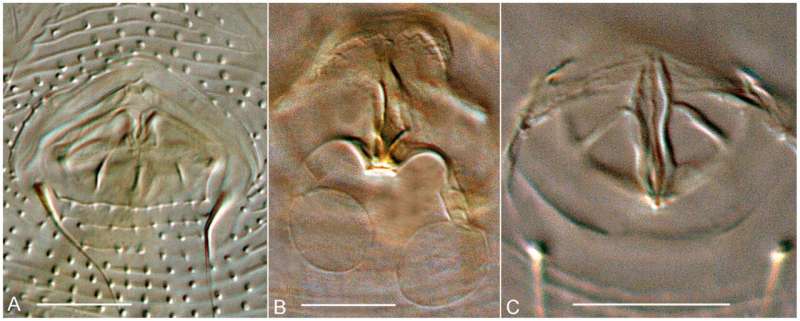Microphotographs of male and female genital structures of Setoptus tsugivagus. Credit: Chetverikov et. al / Systematic and Applied Acarology, 2019
A new species of gall mites (Setoptus tsugivagus) associated with the Western hemlock (a common coniferous tree at the west coast of North America) has been described by a group of scientists from Russia, Serbia and the U.S. The researchers believe that the current classification of the Setoptus mites and other groups should be reconsidered, because species that were previously considered as closely related do not have a common ancestor. The results of the study were published in Systematic and Applied Acarology.
About one-third of microscopic phytoparasites (400 species out of 5000) are gall mites that inhabit coniferous plants. They lack two back pairs of legs and belong to the superfamily of Eriophyoidea (four-legged mites). The group has tree families—Eriophyidae, Diptilomiopidae and Phytoptidae, and the latter include a group called Nalepellinae. This group was divided into three subgroups (tribes): Pentasetacini, Nalepellini and Trisetacini. However, molecular and genetic analyses show that the tribe Pentasetacini is not related to Nalepellini and Trisetacini. Instead, the Pentasetacini was elevated to a separate family, Pentasetacidae, and Nalepellini and Trisetacini were placed in the family Phytoptidae.
The Nalepellinae are characterized by long, recurved spermathecal tubes. This group inhabits Pinaceae, Cupressaceae, and Taxaceae trees. The Nalepellinae are found in North America, Eurasia, and Eastern Asia, which are the areas with the largest diversity of coniferous plants.
A team of scientists from Saint Petersburg State University, the Institute of Zoology of the Russian Academy of Sciences, Tyumen State University, and other universities with their colleagues from the U.S. and Serbia organized an expedition to the conifer forest on the Pacific coast of Canada and studied mites associated with Tsuga heterophylla. The samples included gall mites that were identified as distinct species of Nalepellinae and the genus Setoptus—Setoptus tsugivagus (the species was named for the host plant). The scientists also collected species of the Nalepella genus to analyze the two groups.
The team compared the morphological features of the mites and carried out molecular and genetic analysis to find evolutionary resemblances. They analyzed a DNA gene fragment encoding ribosomal RNA (rRNA). Because rRNA is important for accomplishing a major cellular function, protein biosynthesis, this gene is evolutionarily conservative, usually accumulating only a few changes over millions of years of evolution. It is commonly used to infer relationships between different groups.
"The results of phylogenetic analysis suggest that the genera Setoptus and Nalepella are polyphyletic groups, i.e., they might have different ancestors. Therefore, the whole classification of the Nalepellini group should be reconsidered," said Philipp Chetverikov.
"It also would be interesting to apply a molecular clock analysis to this system to see whether the divergence patterns of mites temporarily coincide with those of their conifer hosts, i.e., if mites and plants co-evolved with each other. We are planning this analysis in the future pending additional mite taxa from various continents to be sequenced," said project participant, Pavel Klimov.
More information: Philipp Chetverikov et al. The description and molecular phylogenetic position of a new conifer-associated mite, Setoptus tsugivagus n. sp. (Eriophyoidea, Phytoptidae, Nalepellinae), Systematic and Applied Acarology (2019). DOI: 10.11158/saa.24.4.13
Provided by University of Tyumen
























